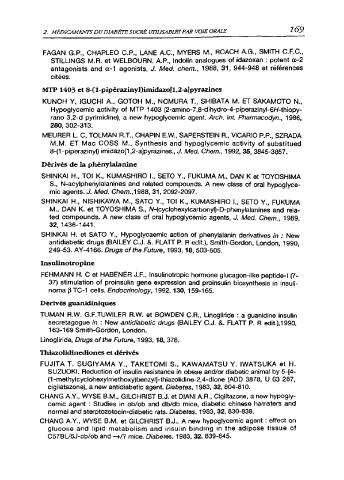Page 208 - Traité de Chimie Thérapeutique 4 Médicaments en relation avec des systèmes hormonaux
P. 208
169
2. MÉDICAMENTS DU DIABÈTE SUCRÉ UTILISABLES PM VOIE ORALE
FAGAN G.P., CHAPLEO C.P., LANE A.C., MYERS M„ ROACH A.G., SMITH C.F.C.,
STILLINGS M.R. et WELBOURN. A.P., Indolin analogues of idazoxan : potent a-2
antagonists and a-1 agonists, J. Med. chem., 1988, 31, 944-948 et références
citées.
MTP 1403 et 8-(l-pipérazinyl)imidazo[l,2-a]pyrazines
KUNOH Y, IGUCHI A., GOTOH M„ NOMURA T., SHIBATA M. ET SAKAMOTO N.,
Hypoglycémie activity of MTP 1403 (2-amino-7,8-dihydro-4-piperazinyl-6H-thiopy-
rano 3,2-d pyrimidine), a new hypoglycémie agent. Arch. int. Pharmacodyn., 1986,
280, 302-313.
MEURER L. C, TOLMAN R.T., CHAPIN E.W., SAPERSTEIN R., VICARIO P.P., SZRADA
M.M. ET Mac COSS M., Synthesis and hypoglycémie activity of substitued
8-(1-piperazinyl) imidazo[1,2-a]pyrazines., J. Med. Chem., 1992, 35, 3845-3857.
Dérivés de la phénylalanine
SHINKAI H., TOI K., KUMASHIRO I., SETO Y., FUKUMA M., DAN K et TOYOSHIMA
S., N-acylphenylalanines and related compounds. A new class of oral hypoglycé
mie agents. J. Med. Chem.,1988, 31, 2092-2097.
SHINKAI H., NISHIKAWA M., SATO Y., TOI K., KUMASHIRO I., SETO Y., FUKUMA
M., DAN K. et TOYOSHIMA S., N-(cyclohexylcarbonyl)-D-phenylalanines and rela
ted compounds. A new class of oral hypoglycémie agents, J. Med. Chem., 1989,
32, 1436-1441.
SHINKAI H. et SATO Y., Hypoglycaemic action of phenylalanin dérivatives in : New
antidiabetic drugs (BAILEY C.J. &. FLATT P. R edit.), Smith-Gordon, London, 1990,
249-53. AY-4166. Drugs ofthe Future, 1993,18, 503-505.
Insulinotropine
FEHMANN H. C et HABENER J.F., Insulinotropic hormone glucagon-like peptide-l (7-
37) stimulation of proinsulin gene expression and proinsulin biosynthesis in insuli-
noma p TC-1 cells. Endocrinology, 1992,130, 159-165.
Dérivés guanidiniques
TUMAN R.W. G.F.TUWILER R.W. et BOWDEN C.R., Linogliride : a guanidine insulin
secretagogue in : New antidiabetic drugs (BAILEY C.J. &. FLATT P. R edit.),1990,
163-169 Smith-Gordon, London.
Linogliride, Drugs ofthe Future, 1993,18, 378.
Thiazolidinediones et dérivés
FUJITA T. SUGIYAMA Y., TAKETOMI S., KAWAMATSU Y. IWATSUKA et H.
SUZUOKI. Réduction of insulin résistance in obese and/or diabetic animal by 5-[4-
(1 -methylcyclohexylmethoxy)benzyl]-thiazolidine-2,4-dione (ADD 3878, U 63 287,
cigliatazone), a new antidiabetic agent. Diabètes, 1983, 32, 804-810.
CHANG A.Y., WYSE B.M., GILCHRIST B.J. et DIANI A.R., Ciglitazone, a new hypogly
cémie agent : Studies in ob/ob and db/db mice, diabetic chinese hamsters and
normal and sterptozotocin-diabetic rats. Diabètes, 1983, 32, 830-838.
CHANG A.Y., WYSE B.M. et GILCHRIST B.J., A new hypoglycémie agent : effect on
glucose and lipid metabolism and insulin binding in the adipose tissue of
C57BL/6J-ob/ob and -+/? mice. Diabètes, 1983, 32, 839-845.

